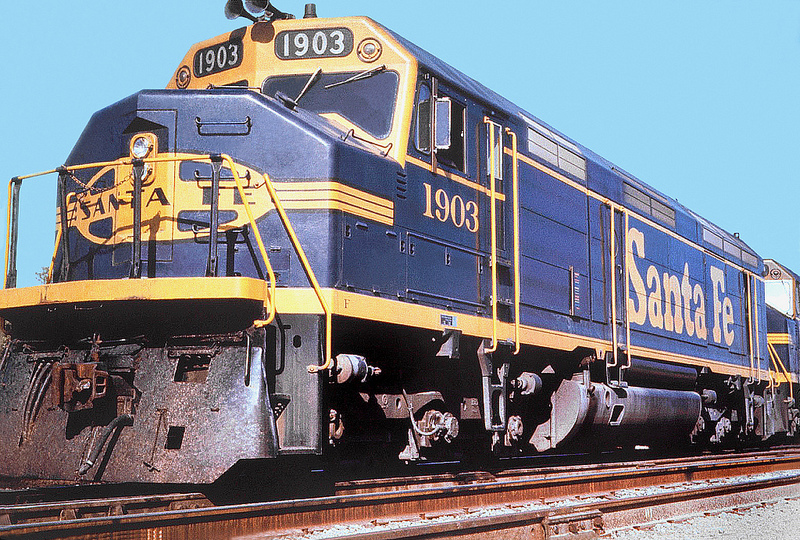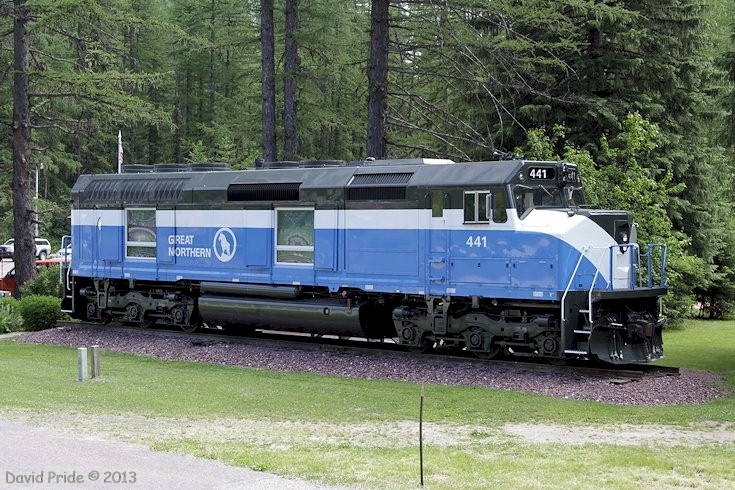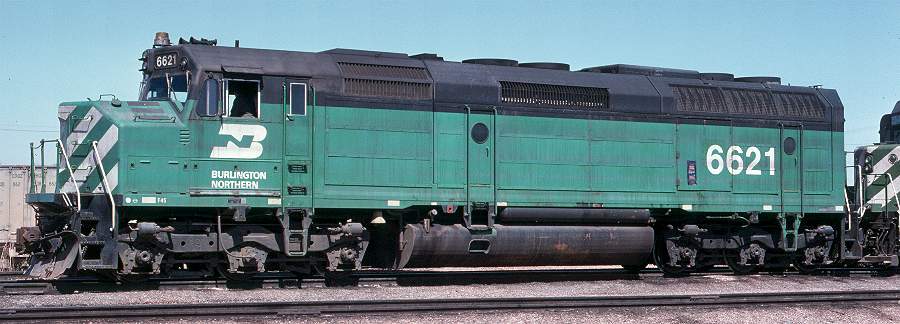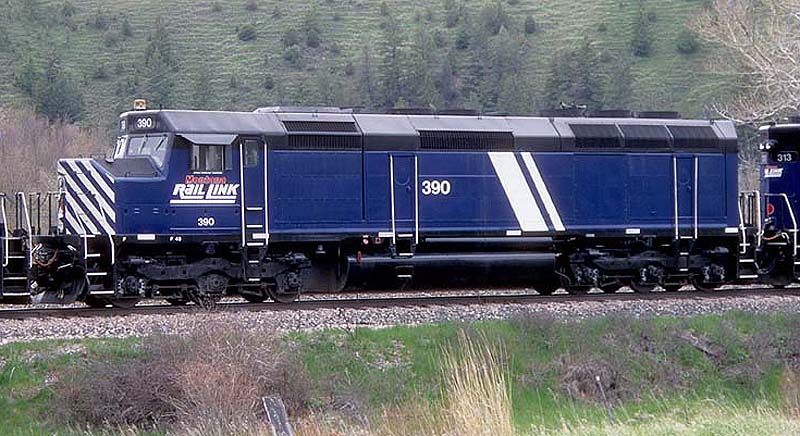History: By the early 1960's the Electro-Motive Division (EMD) was at a big disadvantage. Their 567 engine, in use for over 20 years, had reached it's peak at 2.500 horsepower in a turbocharged 16-cylinder version. EMD released a new 645 engine in 1966. The most powerful locomotive using this series of engine was the SD45, powered by a 20-cylinder turbocharged 645E engine producing 3600 horsepower. Orders from railroads all over the country, especially western roads, poured in. Great Northern received the first one off the production line and Santa Fe took delivery of a 90-unit order the first year.
At the same time Santa Fe was looking to replace it's aging fleet of passenger locomotives. They wanted something more stylish than a freight hood unit with a steam generator for thier famous Super Chief train. EMD had already extended the SD45 frame and added a steam generator to the rear creating the SDP45. They responded to Santa Fe's request by adding a cowl body to the SDP45 thus creating the FP45.
Santa Fe took delivery of the first nine FP45's in December of 1967. Numbered 100-108, they were painted in the red and silver warbonnet passenger scheme with black Roman-style Santa Fe lettering on the sides. The cowl offered a cleaner engine compartment and internal walkways, both of which would lead to production of the F45, a regular SD45 with the cowl. Santa Fe acquired forty F45's in 1968, numbered 1900-1939 and delivered in the blue and yellow 'pinstripe' scheme. The second twenty were equipped with steam lines for use on passenger trains. When Amtrak took over passenger service the FP45's went into the freight pool, receiving blue and yellow paint. The pinstripe paint scheme gave way to the blue and yellow warbonnet scheme by 1980. In the early 80's all 40 FP45's and 8 F45's were rebuilt at the San Bernadino shops. During the failed merger with Southern Pacific seven FP45's and twenty F45's received red and yellow 'Kodachrome' paint. On July 4th, 1989, FP45's 5992 and 5998 were released from the San Bernadino shops as numbers 101 and 102 in the newly revived red and silver 'Super Fleet' scheme with a large Santa Fe on the sides. Two F45's were wrecked and scrapped and one was sold to Wisconsin Central while the remaining six were donated to various railroad museums. Six F45's were sold to Wisconsin Central and the remaining units went to Morrison-Knudsen as lease units with one being assigned and painted for Utah Railway.
Milwaukee Road was the other railroad that bought FP45's. Arriving in late 1968 for Hiawatha passenger service, they wore the UP yellow and gray scheme and were numbered 1-5. They differed from other F45's and FP45's as they did not have dynamic brakes installed. Even before Amtrak arrived these locomotives were re-assigned to freight service between Chicago and the Twin Cities.
Great Northern acquired fourteen F45's, numbered 427-440 and painted in the Big Sky Blue scheme, in 1969. The internal walkways were important to the GN given the winter weather on the line between the Twin Cities and Seattle. Crews no longer had to worry about ice and snow covered walkways like on their hood units. GN planned to run all of their main line freights with a F45 on the point. GN ordered an additional 12 units, which were delivered as Burlington Northern 6614-6625 in 1970. BN continued the F45 purchase in 1971 with 20 additional units numbered 6626-6645. The 46 F45's were regular power on the Chicago to West Coast trains over the former GN lines. Three of the original GN units were leased to Utah Railway for five years after being retired by BN. Two other units were sold to Susquehanna and three went first to Trancisco, then to Wisconsin and Southern, and finally to Montana Rail Link. One of the two Susquehanna units was re-sold to MRL in 1993.
EMD F45:
- Full data sheet on The Diesel Workshop.
- Read more on Wikipedia.
- Read more on American-Rails.com
At the same time Santa Fe was looking to replace it's aging fleet of passenger locomotives. They wanted something more stylish than a freight hood unit with a steam generator for thier famous Super Chief train. EMD had already extended the SD45 frame and added a steam generator to the rear creating the SDP45. They responded to Santa Fe's request by adding a cowl body to the SDP45 thus creating the FP45.
Santa Fe took delivery of the first nine FP45's in December of 1967. Numbered 100-108, they were painted in the red and silver warbonnet passenger scheme with black Roman-style Santa Fe lettering on the sides. The cowl offered a cleaner engine compartment and internal walkways, both of which would lead to production of the F45, a regular SD45 with the cowl. Santa Fe acquired forty F45's in 1968, numbered 1900-1939 and delivered in the blue and yellow 'pinstripe' scheme. The second twenty were equipped with steam lines for use on passenger trains. When Amtrak took over passenger service the FP45's went into the freight pool, receiving blue and yellow paint. The pinstripe paint scheme gave way to the blue and yellow warbonnet scheme by 1980. In the early 80's all 40 FP45's and 8 F45's were rebuilt at the San Bernadino shops. During the failed merger with Southern Pacific seven FP45's and twenty F45's received red and yellow 'Kodachrome' paint. On July 4th, 1989, FP45's 5992 and 5998 were released from the San Bernadino shops as numbers 101 and 102 in the newly revived red and silver 'Super Fleet' scheme with a large Santa Fe on the sides. Two F45's were wrecked and scrapped and one was sold to Wisconsin Central while the remaining six were donated to various railroad museums. Six F45's were sold to Wisconsin Central and the remaining units went to Morrison-Knudsen as lease units with one being assigned and painted for Utah Railway.
Milwaukee Road was the other railroad that bought FP45's. Arriving in late 1968 for Hiawatha passenger service, they wore the UP yellow and gray scheme and were numbered 1-5. They differed from other F45's and FP45's as they did not have dynamic brakes installed. Even before Amtrak arrived these locomotives were re-assigned to freight service between Chicago and the Twin Cities.
Great Northern acquired fourteen F45's, numbered 427-440 and painted in the Big Sky Blue scheme, in 1969. The internal walkways were important to the GN given the winter weather on the line between the Twin Cities and Seattle. Crews no longer had to worry about ice and snow covered walkways like on their hood units. GN planned to run all of their main line freights with a F45 on the point. GN ordered an additional 12 units, which were delivered as Burlington Northern 6614-6625 in 1970. BN continued the F45 purchase in 1971 with 20 additional units numbered 6626-6645. The 46 F45's were regular power on the Chicago to West Coast trains over the former GN lines. Three of the original GN units were leased to Utah Railway for five years after being retired by BN. Two other units were sold to Susquehanna and three went first to Trancisco, then to Wisconsin and Southern, and finally to Montana Rail Link. One of the two Susquehanna units was re-sold to MRL in 1993.
EMD F45:
- Full data sheet on The Diesel Workshop.
- Read more on Wikipedia.
- Read more on American-Rails.com
Railroad/Company: Electro-Motive Diesel (EMD) is an American manufacturer of diesel-electric locomotives, locomotive products and diesel engines for the rail industry. The company is owned by Caterpillar through its subsidiary Progress Rail Services Corporation.
Electro-Motive Diesel traces its roots to the Electro-Motive Engineering Corporation, a designer and marketer of gasoline-electric self-propelled rail cars founded in 1922 and later renamed Electro-Motive Company (EMC). In 1930, General Motors purchased Electro-Motive Company and the Winton Engine Co., combining the two to form its Electro-Motive Division (EMD) in 1941.
In 2005, GM sold EMD to Greenbriar Equity Group and Berkshire Partners, which formed Electro-Motive Diesel to facilitate the purchase. In 2010, Progress Rail Services completed the purchase of Electro-Motive Diesel from Greenbriar, Berkshire, and others.
EMD's headquarters, engineering facilities and parts manufacturing operations are based in McCook, Illinois, while its final locomotive assembly line is located in Muncie, Indiana. EMD also operates a traction motor maintenance, rebuild and overhaul facility in San Luis Potosí, Mexico.
As of 2008, EMD employed approximately 3,260 people, and in 2010 it held approximately 30 percent of the market for diesel-electric locomotives in North America.
From Wikipedia
Electro-Motive Diesel traces its roots to the Electro-Motive Engineering Corporation, a designer and marketer of gasoline-electric self-propelled rail cars founded in 1922 and later renamed Electro-Motive Company (EMC). In 1930, General Motors purchased Electro-Motive Company and the Winton Engine Co., combining the two to form its Electro-Motive Division (EMD) in 1941.
In 2005, GM sold EMD to Greenbriar Equity Group and Berkshire Partners, which formed Electro-Motive Diesel to facilitate the purchase. In 2010, Progress Rail Services completed the purchase of Electro-Motive Diesel from Greenbriar, Berkshire, and others.
EMD's headquarters, engineering facilities and parts manufacturing operations are based in McCook, Illinois, while its final locomotive assembly line is located in Muncie, Indiana. EMD also operates a traction motor maintenance, rebuild and overhaul facility in San Luis Potosí, Mexico.
As of 2008, EMD employed approximately 3,260 people, and in 2010 it held approximately 30 percent of the market for diesel-electric locomotives in North America.
From Wikipedia
Item Links: We found: 1 different collections associated with Rail - Locomotive - EMD F45
- Collection N Scale Model Trains: 151 different items.
Item created by: Alain LM on 2018-04-15 07:28:11. Last edited by Alain LM on 2018-08-03 06:27:52
If you see errors or missing data in this entry, please feel free to log in and edit it. Anyone with a Gmail account can log in instantly.
If you see errors or missing data in this entry, please feel free to log in and edit it. Anyone with a Gmail account can log in instantly.











